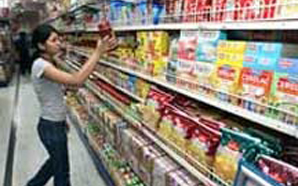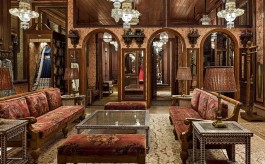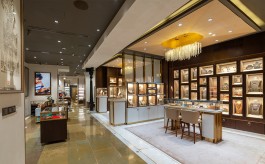FMCG firms tap the pot of gold in Bharat
By Fairy Dharawat | December 03, 2013
The new push is being driven primarily by over 170,000 villages where household income is over Rs 1 lakh a year
 It was an eye-opener for former Hindustan Unilever (HUL) managing director, Nitin Paranjpe, who has now moved on to a global role. At a village home in Tamil Nadu, Paranjpe found a sachet of Comfort fabric conditioner and thought the lady of the home might have mistaken it for a shampoo sachet and bought it to use it on her hair. "What do you use this for," Paranjpe asked; the answer from the lady, "for my clothes", came to him as a welcome surprise, demolishing the popular myth that rural consumers bought only low-end products.
It was an eye-opener for former Hindustan Unilever (HUL) managing director, Nitin Paranjpe, who has now moved on to a global role. At a village home in Tamil Nadu, Paranjpe found a sachet of Comfort fabric conditioner and thought the lady of the home might have mistaken it for a shampoo sachet and bought it to use it on her hair. "What do you use this for," Paranjpe asked; the answer from the lady, "for my clothes", came to him as a welcome surprise, demolishing the popular myth that rural consumers bought only low-end products.Paranjpe's favourite story is now being played out in many more village homes across India. A host of other FMCG companies, including Coca-Cola, Dabur, Godrej, Marico and Emami, are facing a new reality: Rural consumers, armed with higher incomes, are now uptrading to more premium products, and into categories they rarely consumed earlier.
The new push is being driven primarily by over 170,000 villages where household income is over Rs 1 lakh a year. And, many FMCG companies are reaching out to them by creating a direct-distribution mechanism (instead of wholesalers only) for close to a third of these villages with population of more than 3,000. These account for 43 per cent of the rural FMCG potential, marketers say.
Dabur India, for instance, is pushing products like Real range of juices (priced at Rs 25) and Fem bleaching products (Rs 35) that were earlier sold only in urban markets. To deepen the market for packaged juices further, Dabur has now introduced a Rs 10 pack of 125 ml Real juice. The strategy seems to have worked: As much as 5.5 per cent of Real's total sales comes from rural markets.
The share was barely 2.5 per cent two years ago. Sale of bleaching products in rural markets has gone up 10 times in this period.
That is also helping improve margins. Dabur Executive Director (Sales) George Angelo says: "Consumers in rural markets are uptrading their choice of products, helping us increase our margins from rural sales by three percentage points."
Coca-Cola, too, agrees. It says the rural market is no longer driven only by the price tag; it is no longer essential to bring prices down to Rs 5, as the beverage major had tried earlier. The company's vice-president for the marketing & commercial divisions, Debabrata Mukherjee, says the rural strategy earlier was going for "value for money" products, because money was limited. Now, it is "money for value", which means a consumer is ready to pay if a product provides value - something that Coke provides in its quality refreshment.
Mukherjee adds there are two other reasons apart from income growth for this change. One, about 80 million TV households in rural India watch the same programmes and advertisements, leading to rising aspirations. Two, companies like Coke are doing massive sampling of products across village fairs and entertainment events. This enables consumers to taste quality products and creates demand. Every year, in its sampling exercise, Coke covers over 10 per cent of the villages where it is available. Around 25 per cent of the 2.2 million retail outlets where it is available are in rural markets.
Surely, well-heeled rural consumers have seen their incomes going up - the minimum support prices for commodities have doubled in three-four years. Dependence on farm incomes has fallen from 70 per cent to 40 per cent in the past five years, ensuring demand is consistent throughout the year, rather than only after harvest season.
So, even Godrej Consumer Products is tapping these affluent rural consumers, who have the money to splurge and are ready to try out the new product categories that had earlier been predominantly urban-centric. The company's chief operating officer (sales & marketing), Sunil Kataria, says: "The presence of this affluent section in rural areas means you can go beyond the sweet spot of Rs 20 and look for higher-ticket products." The company is now planning to sell Creme hair colour, which it introduced in the urban India at Rs 30, in rural markets as well.
Godrej is also trying to find a solution to the fact that household insecticide market is predominantly an urban affair and has not caught on with even the well-heeled rural customers. So, it has introduced Good Knight Fast Card, a paper mosquito repellant Rs 1 apiece to sample the high-income segment in rural markets. If it works, a new category will open up for the company.
Emami is also targeting the new affluent rural class. For instance, it is offering its popular Navratna Cooling at pack sizes of 100-500 ml, with the top line being sold at a stiff Rs 220-230 a bottle, rather than just the sachets. Similarly it is wooing the youth with Fair and Handsome, available at prices ranging from Rs 10 to Rs 100 in rural markets. Its CEO (sales, supply chain & human capital), N Krishna Mohan, says: "The affluent rural consumers can afford these products. They have aspirations like their urban counterparts and that is why the change is happening."
MARKET DYNAMICS
16.5%: FMCG growth in rural markets between 2008 and 2011 (12.5% in urban markets)
42%: The share of villages with 3,000+ population (57,600 of those in the country) in the all-India rural market potential
67.5%: Of the country's 8 mn retail outlets, about 5.4 mn are located in rural areas, where 70% of India's population lives
Rs 3.75 lakh cr: Rural India's incremental consumption expenditure (more than urban markets' Rs 2.99 lakh cr)
275%: Rise in rural India's per-capita consumption expenditure in 9 years- from Rs 281 in 1990-91 to Rs 1,054 in 2009-10
Rural sales: Account for 35% of total sales for Marico, 47% for Dabur and 30% for Godrej
Advertisement
Related Viewpoints
Chanda P Kumar
Chanda P Kumar, Associate Director- Marketing & Communications, Strategy , FRDC
Adding the right sparkle in jewellery store design
Advertisement









Comments